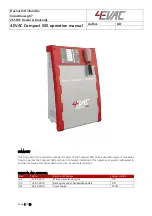
Brotech Electronics Mini Midi Se User Manual 2020-01-01
The format of this file is very specific; each keyword must be followed by -> and then the variable, terminated
with a semicolon. Any text following a semicolon is ignored. If you are using the configuration file, but want some
features to use default settings, you can force the use of a default by beginning the keyword assignment line with a
semicolon. Only use a basic text editor to edit the configuration file, such as Notepad.
The configuration can set the power-on default directory, such as “MAIN_DIR”. There are also audible status
cues available that can alert for directory changes, SD memory card error, and midi file errors. Each cue uses a
single playable note on the instrument, and so one can tell by tone what the status is (a leitmotif of sorts).
Configuration File Keywords
DefaultDirectory: When the mMS powers-on, the default directory is normally {/Root}. This can be changed to any
directory. The format is, DefaultDirectory -> Some_Directory_Name.
ToneStatusBegin: When the mMS powers-on or is directed to change directory, it can briefly play a single note, an
audible confirmation that the mMS and midi instrument are both active. The format is, ToneStatusBegin - >
nn:nnn, where nn = midi track 1-16, and nnn = note 0-127. Example: on our test organ, 1:93 causes a single snare
drum strike. Default is 0:0 = disabled.
ToneStatusEnd: This complements and follows the ToneStatusBegin setting. When the action completes, such as
change directory, the ToneStatusEnd plays a single note, providing an audible confirmation of the activity end.
The format is, ToneStatusEnd - > nn:nnn. Example: on our test organ, 1:94 causes a single cymbal strike. Default
is 0:0 = disabled (and so for a change directory effect we have; snare, change directory complete, cymbal).
ToneStatusFileError: if the mMS detects an SD card error, or SD card directory or file read error, a repeating error
note is played to the instrument. The format is, ToneStatusFileError - > nn:nnn. The default is 0:0 = disabled.
ToneStatusMidiFileError: if the mMS detects a problem with a midi file format, or the file is otherwise corrupted,
a repeating error note is played to the instrument. The format is, ToneStatusMidiFileError - > nn:nnn. The default
is 0:0 = disabled.
BootAllNotesOff: on mMS power-up, it will automatically turn all notes off on all active channels; notes 0 thru
127, and channels 1 thru 16. The assignments are YES (default), or NO
NumberOfChannels: the user can restrict the number of channels that the mMS will work with, anywhere 1 thru 16
inclusive. The default is 16. It is usually not necessary to set this
AllNotesOffMode: During a mid-play STOP command, any playing notes are silenced using any of 3 All Notes Off
modes; 1 = normal manual mode, 2 = midi command 120
All Sounds Off
, 3 = midi command 123 =
All Notes Off
.
If either of 2 or 3 can be used, there is a slight efficiency gain silencing all notes. Some midi to parallel controllers
might employ these built-in midi commands. Default is 1 = manual
DeclencheNote: During an abnormal STOP mid-song play, it might be important for some instruments to reset the
Declenche
or
General Cancel
feature on their instrument, though it is usually not required because songs should
reset the declenche at the beginning of each new song play. The format is Declenchenote -> nn:nnn, with 0:0 =
default disabled. The declenche event plays at the very end of a STOP command, timed as - 100mS delay, 1sec
note on, then note off, effectively resetting the registers. Don’t use this feature if it’s not necessary, as it will delay
the STOP time.
PlayDelay: Set the autoplay in-between song delay (silence) in seconds, 0 - 60 allowed. Default = 4
NotesOffAllSongs: Ensure silence between all songs. Usually NOT necessary and NOT recommended. Can be YES
or NO (Default)
DisplayUserSettings: Diagnostic Tool to display all user settings on the tablet and LCD (MMS) during boot. Usually
NOT necessary, and will significantly slow boot time. Can be YES or NO (Default). To use this diagnostic feature,
in the Configuration File set the keyword to DisplayUserSettings -> YES. Set the hardware Play Mode switch to
default tablet play, and put the tablet into any of sequential or random play modes. Swap the memory card, and
the user default settings will appear on the selection bar two at a time with a 5 second delay between. This means
the boot time will take nearly 2 minutes to boot, so only use it as a diagnostic tool. Schematically, it works like
this,
1) Change the setting in the configuration file to YES, DisplayUserSettings -> YES; (default = NO)
2) Link the tablet to the mMS hardware






























